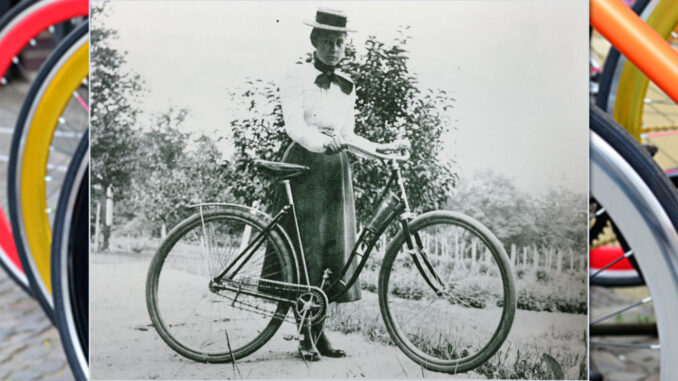
PARK RIDGE—The weather is warming in our little corner of the world, and people are getting outside more. If you lived in the Pascack Valley around 1900, one of the familiar faces you might have seen out and about was Lulu Doerries, pictured here.
With her straw hat and a skirt featuring a hemline raised to calf length, Lulu’s outfit is typical of what a woman would have worn for bicycle riding at the turn of the century. This was decades before it became acceptable for a woman to wear pants.
Lulu was the daughter of German-born Ferdinand Doerries, a Park Ridge farmer, and wife Katharine. The fifth child, Lulu was born around 1886.
While bicycles are a mode of transportation we take for granted in 2023, at the turn of the 20th century they were still a rather new development.
Prior to the 1880s, the “penny-farthing” or “ordinary” (the quintessential “old-timey” bicycle with a large front wheel and small back wheel) was the only option available. It was fast, but unsafe—if the rider came upon a bad patch of road (and remember, these are days before paved streets), she could easily be thrown over the large front wheel and end up with two broken wrists trying to break the fall. Accordingly, the penny-farthing was primarily a pastime for adventurous young men.
Then in the 1880s came a game-changing invention in the world of cycling: the chain-driven “safety bicycle,” which had two wheels of the same size and looked much like our modern bicycle. With a drastically smoother and safer ride, the bicycle became popular among women and men of all economic backgrounds for both transportation and recreation. By the mid-1890s, America was fully engulfed in a bicycle craze.
The bicycle was a crucial component in America’s gradual shift toward gender equality. As bicycles became safer and cheaper, women gained an unprecedented level of freedom and mobility.
The suffragist Susan B. Anthony wrote in 1896, “I think [the bicycle] has done more to emancipate women than any one thing in the world. I rejoice every time I see a woman ride by on a bike. It gives her a feeling of self-reliance and independence the moment she takes her seat; and away she goes, the picture of untrammeled womanhood.”
— Kristin Beuscher is president of Pascack Historical Society.
